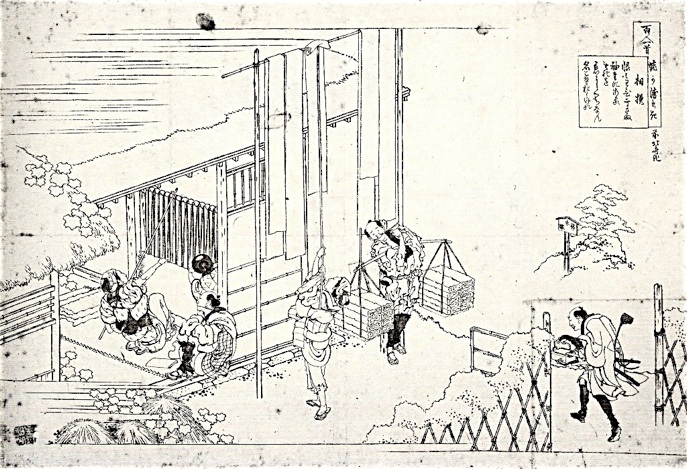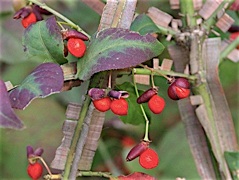相模

恨みわび
ほさぬ袖だに
あるものを
恋に朽ちなむ
名こそ惜しけれ
さがみ
うらみわび
ほさぬそでだに
あるものを
こいにくちなん
なこそおしけれ
Lady Sagami
Even when I hate
Having to dry my sleeves
Wet with tears,
Worse is that this tainted love
I no longer want to cherish.
Hokusai
Sagami (1000 - 1061?) is thought to be the daughter of Minamoto no Yorimitsu. Her husband, Oe no Kimiyori, was governor of Sagami province. After her divorce she served princess Shushi. She belongs to the Thirty-Six Immortal Poets. 108 poems by her are known.
It seems Hokusai is having some fun with his drawing. Brocades, coloured cloths, are hanging to dry at what seems like a brocade workshop. There is a sign on the right, probably reading nishiki gi tsuka. Nishiki is brocade, ki is wood or tree, and tsuka is a mound, like on a grave. So it could mean ‘brocade grave’ or refer to the nishikigi story. Nishikigi is a brocade tree (euonymus alatus, burning bush) with red berries. Nishikigi is also the name of a No play by Zeami Motokiyo (translated by Ernest Fenollosa and finished by Ezra Pound). The story is about a young man who had offered to his beloved the nishikigi, painted sticks of wood representative of his love, but they were refused, and now in grief both spirits wander near the young man’s grave, separated in death as in life. The nishikigi are supposed to be sprigs planted in front of the house of the loved one. If the sprig was not taken inside, the suitor continued with planting new sprigs.
The drawing is a bit cryptic. What is the samurai bringing in? Iro, paint to colour the brocades? As we know iro can also mean ‘desire’.



I have a feeling that na koso should not be read as ‘my reputation for sure’ but rather as nakoso, meaning that the wish to cherish this (damaged) love is no longer present, that it can no longer carry this name. This would make Hokusai’s drawing more understandable, as we see the woman busy working the cloth, not paying any attention to the men around. And the nishikigi outside, together with the sign, would mean that love is dead. There is more to Hokusai than meets the eye.

Nishikigi, euonymus alatus, spindle wing
Stem with peculiar spindle wings